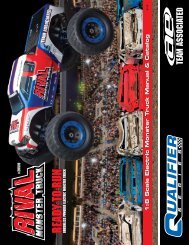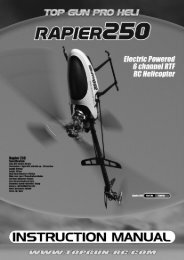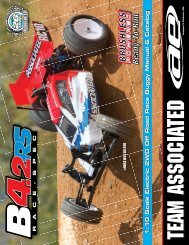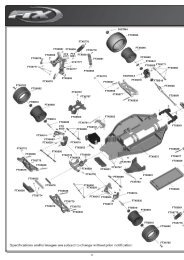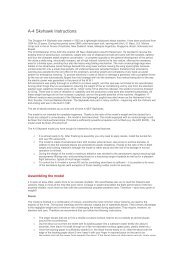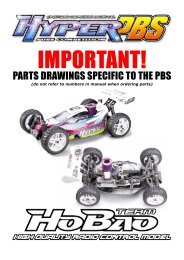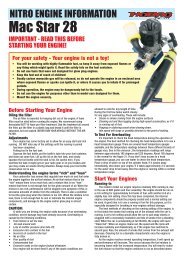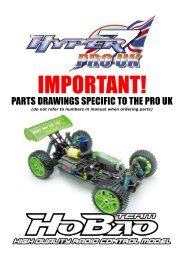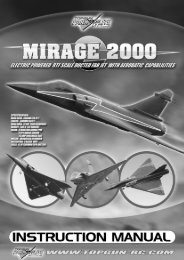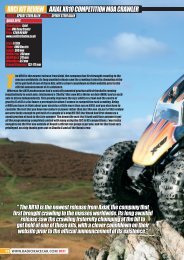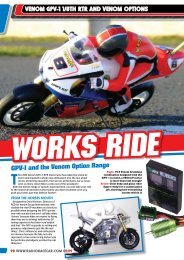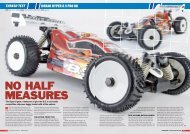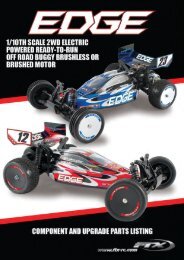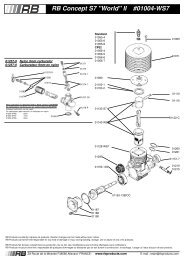HoBao Mini ST reviewed in RRCi - CML Distribution
HoBao Mini ST reviewed in RRCi - CML Distribution
HoBao Mini ST reviewed in RRCi - CML Distribution
You also want an ePaper? Increase the reach of your titles
YUMPU automatically turns print PDFs into web optimized ePapers that Google loves.
cifeature<br />
Left: Optional fastrax<br />
‘Bump Box’ makes<br />
start<strong>in</strong>g all 1/18th to<br />
1/12th I/C models a<br />
breeze, and lasts for<br />
ages when fitted with<br />
4200 mAh Intellect<br />
Below: Low profile air filter,<br />
easy grab fuel tank lid and <strong>in</strong><br />
l<strong>in</strong>e fuel filter are all standard<br />
kit<br />
MINI HYPER <strong>ST</strong><br />
Below: Essential<br />
equipment, but you’ll<br />
also need a fuel bottle<br />
and glow start too<br />
Left: Swept lower<br />
arms allow maximum<br />
droop and travel<br />
Below: Radio box has room for full size<br />
receiver and AAA battery pack. Note<br />
transponder mount <strong>in</strong> lid, rubber covered<br />
switch<br />
Right: Pivot ball front<br />
suspension, threaded<br />
alloy shock bodies,<br />
shock boots and<br />
turnbuckle steer<strong>in</strong>g<br />
l<strong>in</strong>ks<br />
Below: Superb kit tyres. CV jo<strong>in</strong>t<br />
captures pivot p<strong>in</strong> <strong>in</strong> bear<strong>in</strong>g. PBS is<br />
super smooth and slop free<br />
Below: Tw<strong>in</strong> post steer<strong>in</strong>g, easy<br />
f<strong>in</strong>ger access servo saver adjuster<br />
nut, additional alloy chassis plate<br />
and diff case braces<br />
Below: Plenty of steer<strong>in</strong>g lock, and a crash<br />
back front bumper mount!<br />
world is your oyster regard<strong>in</strong>g tyre choice, <strong>in</strong>clud<strong>in</strong>g anyth<strong>in</strong>g from the<br />
current Pro-L<strong>in</strong>e range so you should be able to dial <strong>in</strong>to your local track<br />
whether it be AstroTurf, mud or grass.<br />
The centre brake assembly carriers tw<strong>in</strong> steel brake discs are clamped<br />
between fibre l<strong>in</strong>ed pads, and the front to rear brake bias is fully<br />
adjustable thanks to the separate l<strong>in</strong>k rods to the throttle servo. Both<br />
brakes are shielded from fuel spills by a top cover, and the assembly sits<br />
on top of a centre chassis re<strong>in</strong>forcement plate, with struts front and rear<br />
from chassis plate to diff case for extra rigidity. The brake assembly and<br />
centre diff are slightly off centre on the hard anodised chassis plate,<br />
so the propshafts work at a slight angle, but this helps br<strong>in</strong>g the eng<strong>in</strong>e<br />
further towards centre l<strong>in</strong>e, and the fact that the eng<strong>in</strong>e is tilted over<br />
by a whopp<strong>in</strong>g 20 degrees means the mass is central for better weight<br />
distribution and high speed corner<strong>in</strong>g.<br />
SEALED QUAD GEARED TRIPLETS<br />
The three differentials feature both O-r<strong>in</strong>g and gasket sealed cases,<br />
which are huge, accommodat<strong>in</strong>g the oversize planetary and ma<strong>in</strong> gears<br />
with<strong>in</strong>. Hav<strong>in</strong>g four planetary gears spreads the loads and keeps them<br />
very smooth, while a sealed diff case means you can tune their action<br />
with proper silicone diff oils, which begs the question, why are the diffs<br />
just filled with th<strong>in</strong> grease? I would suggest runn<strong>in</strong>g the eng<strong>in</strong>e <strong>in</strong> as<br />
supplied, which will take all the high po<strong>in</strong>ts off the diff gears as well as the<br />
eng<strong>in</strong>e <strong>in</strong>ternals, and then swapp<strong>in</strong>g all three diffs out to a sensible diff<br />
oil, probably follow<strong>in</strong>g the usual practice <strong>in</strong> 1/8th Truggy/Buggy rac<strong>in</strong>g;<br />
7K front, 10K centre and 3K rear diff oil weight. The easy access diff cases<br />
made the job a real breeze, so that’s what we did for race day and it was<br />
spot on!<br />
MY FAVOURITE THINGS<br />
While the rear drive is distributed by good old dependable dog bones,<br />
the front drive shafts have to cope with steer<strong>in</strong>g angles as well as the<br />
range of suspension movement, so thankfully they feature CV jo<strong>in</strong>ts<br />
whose pivot p<strong>in</strong> is held captive with<strong>in</strong> the wheel bear<strong>in</strong>gs so there’s no<br />
escape for the p<strong>in</strong> and the grub screw hold<strong>in</strong>g it <strong>in</strong> place is redundant.<br />
One of my favourite features on any vehicle, reliability built <strong>in</strong> by design.<br />
Another nice design idea I found on re-assembl<strong>in</strong>g the front and rear diffs<br />
(sadly not the centre diff as the output cups drive the brake discs) is that<br />
the bear<strong>in</strong>gs are of such a large diameter that they fit over the output<br />
cups, but why am I so excited? It means you can change the diff bear<strong>in</strong>gs<br />
without hav<strong>in</strong>g to strip the diff completely and remove the output cups to<br />
exchange the bear<strong>in</strong>gs. When you have seen as many trucks and buggies<br />
as I have, it’s the little th<strong>in</strong>gs that impress the most.<br />
The front suspension features pivot ball equipped upper and lower<br />
arms, captive <strong>in</strong> adjustable cover plates, so you can get perfectly<br />
free movement without any slop that would make the steer<strong>in</strong>g feel<br />
unpredictable. The swept lower arms and long travel shocks ensure that<br />
any hard land<strong>in</strong>gs make the chassis plate slap on the floor before the<br />
shocks top out, reliev<strong>in</strong>g any stress on the shock <strong>in</strong>ternals or their alloy<br />
mount<strong>in</strong>g towers.<br />
The alloy shock bodies are threaded for easy ride height adjustments,<br />
and wear a shock rod boot to keep dust and dirt out of the shaft seals for a<br />
longer more reliable work<strong>in</strong>g life. With multiple upper and lower mount<strong>in</strong>g<br />
positions you can dial the chassis <strong>in</strong>to any track or driv<strong>in</strong>g style required.<br />
With spacers on the front upper arm pivots to allow castor changes<br />
and turnbuckles on the steer<strong>in</strong>g l<strong>in</strong>ks plus rear camber connectors you<br />
can really f<strong>in</strong>e tune the chassis, bend<strong>in</strong>g it to your will. The upper rear<br />
arms have multiple <strong>in</strong>ner and outer mount<strong>in</strong>g locations for chang<strong>in</strong>g roll<br />
centres, while the lower arms even have droop screws <strong>in</strong>corporated <strong>in</strong>to<br />
the design, push<strong>in</strong>g directly aga<strong>in</strong>st the chassis plate to limit the down<br />
travel of front and rear arms, allow<strong>in</strong>g you to dial <strong>in</strong> the handl<strong>in</strong>g on extra<br />
bumpy conditions, or hunker it down when the go<strong>in</strong>g gets fast and smooth.<br />
The lower arms are a ladder style for maximum strength, moulded<br />
<strong>in</strong> a material that is sufficiently pliable to absorb the knocks and keep<br />
on runn<strong>in</strong>g. Reliability is most def<strong>in</strong>itely the key to any successful race<br />
chassis. To f<strong>in</strong>ish first, first you have to f<strong>in</strong>ish!<br />
The only tun<strong>in</strong>g features I can see absent from its bigger brothers is the<br />
eccentric <strong>in</strong>serts used <strong>in</strong> the lower pivot l<strong>in</strong>k plates to allow quick rear toe<br />
changes, so I presume optional l<strong>in</strong>k plates will be available to allow this<br />
simple yet crucial tun<strong>in</strong>g aid. More rear toe adds stability at high speed<br />
over bumpy ground at the cost of turn<strong>in</strong>g ability. Less rear toe makes for<br />
a sharper steer<strong>in</strong>g truck but it will be far more nervous on the high speed<br />
section of the track. Set at 3 degrees is a typical sett<strong>in</strong>g so perhaps <strong>HoBao</strong><br />
have done all the sums and test<strong>in</strong>g for you and set it that the optimum<br />
condition straight from the box. The front-end is set with a good degree<br />
of toe out to make it responsive to steer<strong>in</strong>g <strong>in</strong>puts, giv<strong>in</strong>g a good <strong>in</strong>itial<br />
response, and putt<strong>in</strong>g the front suspension through its range there is<br />
negligible bump steer so it rema<strong>in</strong>s stable and accurate over even the<br />
roughest terra<strong>in</strong>.<br />
The blue anodised alloy radio tray holds two full size H-101 servos, so<br />
you can easily upgrade these at a later date if you f<strong>in</strong>d yourself need<strong>in</strong>g<br />
better steer<strong>in</strong>g or throttle response. The radio box holds a 4 AAA battery<br />
case and a full size 27 MHz receiver, but it is cavernous, easily big enough<br />
to get a little Novak LiPo and regulator <strong>in</strong> there to speed up the servos.<br />
The radio switch lives on the side of the radio tray and wears a rubber<br />
cover to afford it some wet weather protection, and the radio box lid<br />
clamps all cables with<strong>in</strong> grommets to help prevent moisture <strong>in</strong>gress. The<br />
radio box lid also <strong>in</strong>corporates a three-po<strong>in</strong>t mount<strong>in</strong>g for the AMB PT<br />
(Personal Transponder) you will need on race day. It mounts from <strong>in</strong>side,<br />
face up so you can read your transponder number from the outside with<br />
the top face flush with the radio box lid, what a great touch. It’s a shame<br />
the radio lid is reta<strong>in</strong>ed by three screws <strong>in</strong>stead of R-clips, as you will<br />
need to open it regularly if runn<strong>in</strong>g 27 MHz to change crystals at a race<br />
meet<strong>in</strong>g, and to recharge or swap the receiver batteries as there is no<br />
78 WWW.RADIORACECAR.COM 10/08<br />
10/08 WWW.RADIORACECAR.COM 79



